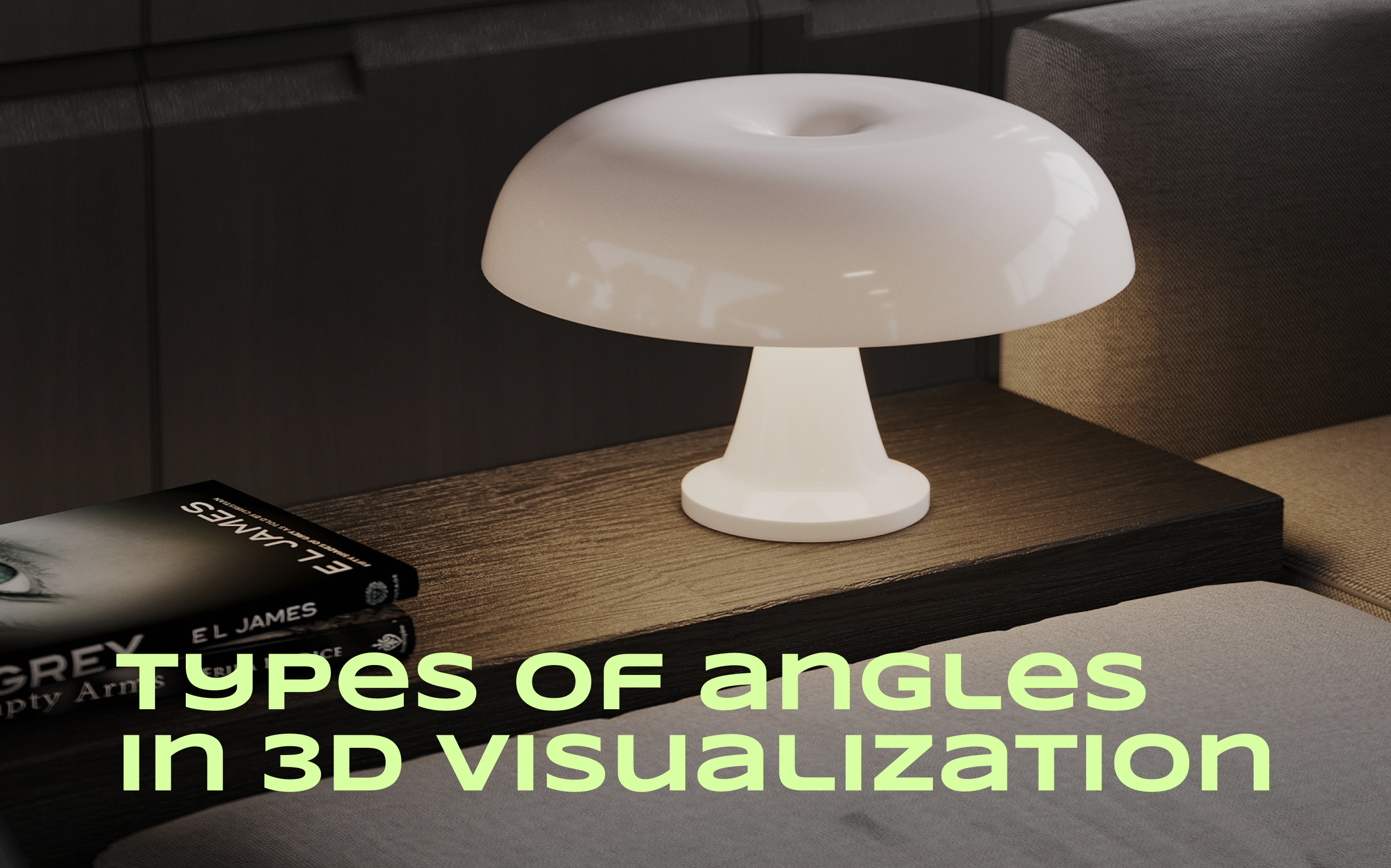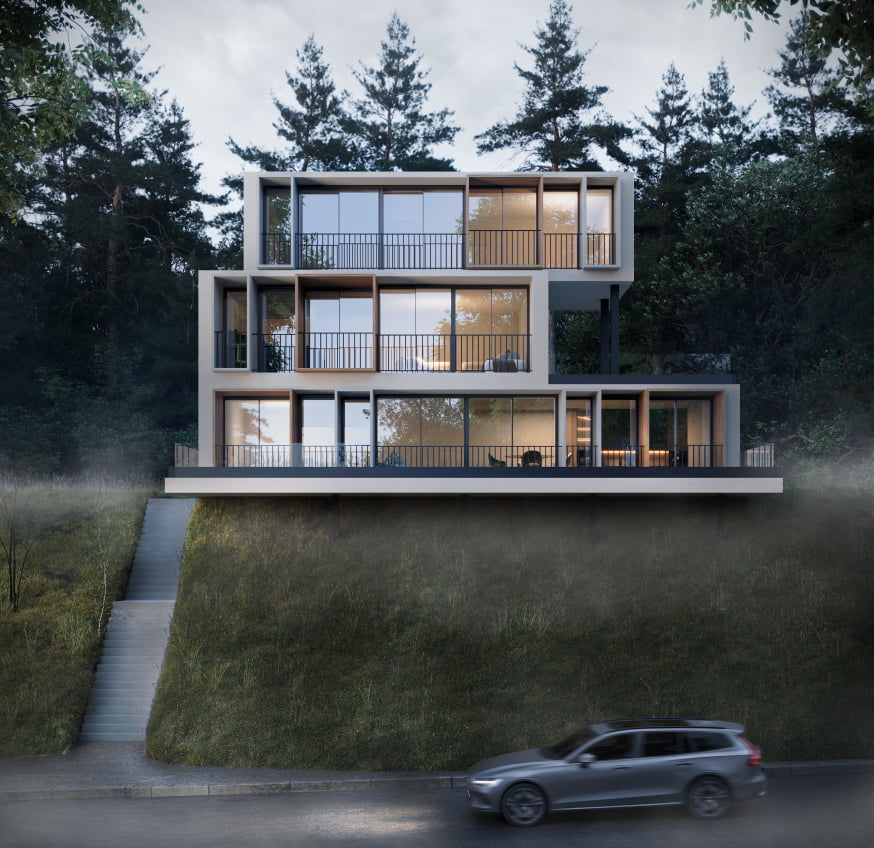Types of angles in 3D visualization


Seeking Ideal Angles for Your 3D Visualization Project?
You can change the point of view. But it’s better to change the shooting angle to bring a breath of fresh air into the frame. You can have broad perspectives, but for a complete view of the picture, wide angles are preferable. You can distance yourself from the object of adoration, but the main thing is to do it out of love. Love for architectural visualization.
In rendering a 3D scene, one object may be less significant, another – the most important. The camera when visualizing a residential complex endlessly changes its position vertically in search of that perfect majestic shot. Its position determines the composition and accent details standing out against the background of a dark green sofa in the room. At the same time, the sleeping area may “lose” its position to the wall-mounted lamp – it all depends on your vision and the angle from which you look at the object. This is called an angle.
An angle is the height from which the camera shoots. In other words, the shooting angle. Setting its parameters is important, as they can give the client a clear understanding of the length of the room walls.
We are more familiar with this concept in relation to the art of photography, cinema, and even the gaming industry, where the client can feel akin to a character. Designers can easily direct the hero’s attention to specific objects, make them keep him in constant tension, if it’s a horror genre, or under adrenaline, if it’s necessary to break away from the “cops” in GTA.
In addition, angles play a role in recreating an overall attractive view, which can be achieved not only with the help of the wide-angle camera of the latest iPhone, but also thanks to 3D visualization. Renderings of building facades and entire cities, made with special software, do not yield in realism to a picture “snapped” on a smartphone or a professional Sony A7R V.
In this realism of 3D visualization, angles often take the first place even compared to the processes of selecting materials or setting up the necessary lighting. Therefore, to produce quality images, we will tell you what the shooting angle is in interior design and what it tells when a “threatening” skyscraper is in front of your eyes.
Angular perspectiveAngular perspective
The spider, hiding and settling in the upper corner near the ceiling of your room, knows better than anyone what this type of perspective represents.
Here, the client has almost the same options as the “octopus.” They can understand the scale and functionality of the entire room, examine each chair and piece of furniture, as well as the color of the wallpaper or walls in the project. This perspective covers a huge space, often neglecting composition but serving as an excellent tool for gathering feedback from the client. It can also bring a certain dynamic to the frame.
Side perspectiveSide perspective
With this perspective, the depth of interior objects is clearly visible, but the number of objects in the frame is reduced due to the deliberate limitation of the viewing angle. In this case, to showcase the entire room, several frames are needed. The interior can charm not only with its panoramic windows, through which fluffy snowflakes fall, but also with a sense of coziness and privacy, which the side view can enhance. With it, you are positioned to the side and observe what is happening – for example, you can imagine how you will be warming up with a cup of fragrant cocoa in the future, while the fire crackles in the fireplace.
Frontal perspectiveFrontal perspective
It is also called the frontal perspective. It can accentuate, for example, one of your paintings that you recently acquired at an auction. It hangs on the wall above the bed and harmoniously complements the bedroom’s decor. At the same time, you see everything that surrounds the “framed” artwork, whether it’s a wall painted in white or patterned wallpaper.
If the first two perspectives are considered informative, this type is on the border with artistic, as it draws attention not to the entire contents of the room, but only to a part of it. This happens because in the frontal perspective, the camera is set strictly perpendicular to the walls.
Top-down perspectiveTop-down perspective
Think of yourself as a 15-year-old in a geography class next to the board with a map. Finding the northernmost point of Australia on it is only possible when you approach closely with a pointer in hand. But to see the whole “world,” you need to step back a few paces.
The top-down perspective on interior renderings works on the same principle. Its goal is to fully showcase the room’s layout with its materials, lighting, and colors. Such images may look quite chaotic and indistinct because the chandelier shades and curtains on the cornice are in a similar suspended state when you can’t find that same Cape York. In other words, the elements in the image visually lack “gravity.” This perspective is helpful when you need to show “a lot” in one shot and is excellent for demonstrating very narrow spaces.
Perspective of a volumetric schemePerspective of a volumetric scheme
A challenging task for a visualizer is to provide a budget option for the client. Renders made from this perspective resemble volumetric diagrams and are used to showcase the entire project. They “cut through” the walls, making the ceiling and doors transparent to reveal the interior details. Notably, a room built from scratch will inherently accommodate fewer decor elements than in multiple frames of the same visualization. This option is difficult because achieving its flawless artistic quality requires a lot of effort.
Bird’s eye viewBird’s eye view
This is the slang term used by designers for a perspective from a bird’s-eye view. Logically, it is implemented as a top-down perspective, but it does not limit itself to interior decor elements. It helps to observe what is around your home – capturing the entire location. Roads, parks, forests, neighboring office buildings – all the infrastructure and landscaping. It’s important to follow one rule – for the residential complex you want to depict, it’s best to place it in the middle of the render, leaving about 20% of the “surrounding environment” from each edge. This is done for further cropping during scaling. In this regard, it is good to follow the modified proverb: try seven angles to later crop the needed fragment without losing the meaning.
Close-up perspectiveClose-up perspective
This perspective highlights an object against the general composition. It is achieved through focus and blurring of the background and is considered uninformative. It is often used not only for object visualization but also in advertising a specific product (or when presenting this product to the client). By choosing this perspective, renders become clear and expressive from an artistic point of view.
Worm’s eye perspectiveWorm’s eye perspective
It seems that no one suffers in the world as much as men when they need to take a photo of their partner. For them, it’s better to undergo training in finding the “long and slender legs” perspective right away, to not clutter the phone’s memory and waste time choosing the best shot from a thousand. Here’s where the worm’s eye view comes to the rescue.
Primarily, of course, this method is a good trump card in the hands of a photographer. With it, you can depict the grandeur of Gothic-style buildings. Even make them look “menacing” and dominating. Or, for example, “gather” the entire football team around the lens to reflect the emotional charge and unity before an important match.
But a visualizer can also confidently embrace the principles of adjusting the “from below” angle and use it skillfully. For example, if you need to showcase a composition with a strict verticality – urban development or a wooden chalet-style house in the mountains peeking out from behind the forest – then the ground-level perspective is perfect. Or imagine how you can restore the former grandeur of the burnt masterpiece of medieval architecture, Notre-Dame de Paris, in renderings by finding just the right shooting angle?
For this reason, perspective is a delicate but fundamental matter. It leaves an indelible mark on perception. Aesthetics, storytelling, “engagement” – the few but important functions that perspective can fulfill in 3D visualization. A high-quality render with the camera in the right place creates unforgettable, sometimes even sensual, impressions for the client, immersing them in the world they have long dreamed of.
SHARE THIS...

Unlock the Potential of Your Project with Our 3D Visualization Expertise
Our other articles
Get in touch
The art of 3D visualization is our passion. We specialize in a wide range of services to bring
your ideas to life. In our arsenal, we have architectural rendering, interior visualization, 3D product visualization, 360-degree panoramas, virtual reality (VR), architectural animation, rendering
for metaverses, and many other capabilities.
If you’re looking to elevate your business with stunning visualizations, simply fill out the form below. Our team will get in touch with you shortly to kickstart work on your project. Let’s collaborate to create visualizations that will amaze your clients and help you achieve your goals.
Contact us







